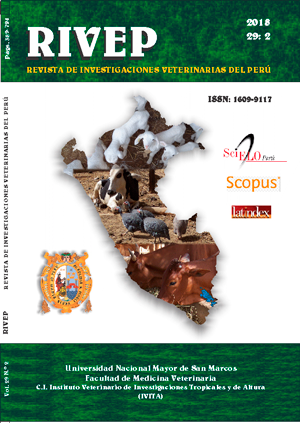Association between serum dopamine and serum total cholesterol in dogs
DOI:
https://doi.org/10.15381/rivep.v29i2.14480Keywords:
dopamine, cholesterol, clinical ethology, aggressiveness, dogsAbstract
The relationship between total cholesterol (Colt) and dopamine (DA) was investigated for the possibility of having an accessible exam in consultation such as the measurement of total cholesterol (Colt) to project the behavior of serum DA. The Colt was determined in 50 dogs and based on the results three study groups were formed, Group I: 6 patients with Colt between 77 and 200 mg/dl; Group II: 6 patients between 250 and 300 mg/dl; Group III: 6 patients between 400 and 470 mg/dl. Serum DA was measured in the 18 patients through HPLC coupled to an electrochemical detector. It was found a wide distribution of data regarding the determination of Colt (291.8 ± 62.0 mg/dl) and DA (68.8 ± 17.8 μg/ml) with a low correlation between them. The analysis by study group shows a greater correlation of DA for low concentrations of serum cholesterol, and the analysis of slopes shows that the variation in the concentration of DA is greater in cases of small variations of cholesterol in group II.Downloads
Downloads
Published
Issue
Section
License
Copyright (c) 2018 Gonzalo Chávez C., Mauricio Maturana E., Claudia Rojas Z., Francisco Cuevas C.

This work is licensed under a Creative Commons Attribution-NonCommercial-ShareAlike 4.0 International License.
AUTHORS RETAIN THEIR RIGHTS:
a. Authors retain their trade mark rights and patent, and also on any process or procedure described in the article.
b. Authors retain their right to share, copy, distribute, perform and publicly communicate their article (eg, to place their article in an institutional repository or publish it in a book), with an acknowledgment of its initial publication in the Revista de Investigaciones Veterinarias del Perú (RIVEP).
c. Authors retain theirs right to make a subsequent publication of their work, to use the article or any part thereof (eg a compilation of his papers, lecture notes, thesis, or a book), always indicating the source of publication (the originator of the work, journal, volume, number and date).



